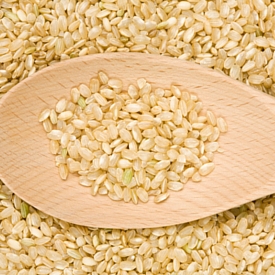
Rice has been one of the most important foods in the world for thousands of years. Archaeological discoveries have found primitive rice seeds and ancient farm tools dating back about 9,000 years. For the majority of its long history, rice was a staple only in Asia, finding its way to Europe in the 8th century and eventually to South America in the 17th century.
Not surprising, the majority of the world’s rice is grown in Asia, where it plays an incredibly important role in their food culture. Thailand, Vietnam and China are the three largest exporters of rice. Today, rice provides nearly 50% of the daily calories to half of the world’s population.
Thanks to the U.S. Department of Agriculture, brown rice is rising to celebrity status in the food world. Last year, this government agency released a completely revised food pyramid which recommended that we eat mostly whole grains instead of refined grains. Whole grains, like brown rice, are more nutritious than refined grains, like white rice. The basic difference between white and brown rice is the extra processing involved in turning brown rice into white rice. While this processing creates a better shelf life for rice, it takes an extremely healthy food and basically turns it into empty calories. The processing destroys 67% of the vitamin B3, 80% of the vitamin B1, 90% of the vitamin B6, half of the manganese, half of the phosphorus, 60% of the iron, and all of the dietary fiber and essential fatty acids.
By law in the United States, fully milled and polished white rice must be “enriched” with vitamins B1, B3, and iron. While enrichment helps, it is not the same as the original nutrients in the brown version. And along with the fiber, at least 11 other nutrients are not replaced in any form.
Some of the key nutrients in brown rice include B vitamins, maganese, selenium, iron and fiber. The health benefits of brown rice read like a laundry list to disease prevention and boosting the immune system. These benefits include lowering cholesterol, reduced risk of diabetes, heart disease, heart attack, stroke and colon cancer, reduced severity of asthma, and lower frequency of migraine headaches. Whole grains, like brown rice may also help women in weight management. An obesity study conducted at the Harvard School of Public Health showed that women who consistently consumed more whole grains weighed less than women who consumed fewer.
When it comes to eating brown rice, most people discover the nutty flavor is far more appealing than the bland taste of it’s stripped down relative. We hope the whole family enjoys it!
Age to introduce: About 6 months old (prueed infant cereal only). About 12 months for cooked grain texture.
Baby Treat: My First Cereal
Rice is easily digested and has low allergen aspects, so it is commonly recommended as the first food you introduce to your baby. Many of the recipes for making baby cereals are time consuming, but with the use of the freezer and a blender, homemade rice cereal is simple and convenient.
This recipe is perfect for infants, but by adding a few “extras” it will tempt the taste buds of kids and adults.
Ingredients:
- 3 cups of brown rice, cooked according to package directions
- 12 ounces breast milk, water, or infant folrmula
Directions:
Place the cooked brown rice in a blender with the breast milk/water/formula. Puree until completely smooth – you cannot make this cereal too smooth. Pour the cereal into ice trays, cover and freeze overnight. Once frozen, pop the cubes out of the trays, place in a freezer bag or container, labeled with the date and return to the freezer. Lasts up to 2 months.
To serve:
Defrost the cubes, and add breast milk or formula to develop a smooth consistency. For babies just starting solids, thin the cereal to a semi-liquid consistency. Warm the cereal, if desired. You can also change the flavor of the cereal by adding fruit or veggie baby food.
Brown Rice For The Family
At the market: Brown rice contains natural oils, which can turn rancid on the shelf. For packaged rice, check for usability dates and when buying in bulk, choose a store that has a high turnover. If organic brown rice is available, consider purchasing it over conventionally grown rice. Conventionally grown brown rice has been found to contain small traces of arsenic. While the levels of arsenic are low and will not cause immediate illness, the build up of arsenic in the body, might be linked to some cancers.
Storage: Oil-rich brown rice will turn rancid at room temperature. If stored in a tightly closed container in the refrigerator or freezer, it will stay fresh for up to a year.
Tips on cooking rice: Rice can be a little tricky to cook perfectly. Here are a few tips from the U.S. Rice Federation that will help you out:
- Accurately measure rice and liquid.
- Set timer to prevent under or over-cooking.
- Keep lid on pot during cooking to prevent steam from escaping.
- Rice triples in volume. Use cookware appropriate for the amount of rice you are preparing.
- Do not stir. Stirring releases the starch, resulting in rice that is sticky.
- At the end of cooking time, remove lid and test for doneness. If rice is not tender or liquid is not absorbed, cook 2 to 4 minutes longer.
- When rice is cooked, fluff with fork or slotted spoon to allow steam to escape and keep the grains separate.
For those who plan ahead, soaking brown rice overnight cuts the cooking time dramatically. Soak the rice in the measured amount of water you’ll need to cook it, and cook it in the same water, adding more if necessary. DO NOT drain the rice after soaking it, nutrients will be lost.
For those who do not like to cook rice, you can pick it up from your local chinese restaurant. Almost all chinese restaurants offer a choice of white or brown rice.
Creative and tasty ideas for adding brown rice to your familiy meals:
Never serve a boring side dish ever again. Adding a few simple ingredients to brown rice will put a gourmet spin on any family dinner. After your brown rice has been cooked, and while it is still in a hot pan, try adding any of these ingredients:
- Chopped cilantro, parmesan and lemon zest with 2 Tbsp olive oil.
- Chopped mango, black beans, 1 Tbsp lime juice, and 1 Tbsp olive oil
- Chopped, cooked shitake mushrooms, green peas, sesame seeds (or a drizzle of sesame oil) and 2 tbsp. olive oil
- Chopped tomatoes, scallions 1Tbsp lemon juice, and 1 Tbsp Olive oil
- Chopped pineapple, cilantro, and 2 tbsp coconut milk
- Chopped cooked carrots, sliced almonds, and fresh parsley, ad 2 Tbsp olive oil
- Creamed spinach, crumbled gorgonzola, and chopped walnuts
- Chopped cooked broccoli, cubed firm tofu, 1 Tbsp soy sauce, and 1 Tbsp olive oil
Don’t throw out leftover rice. It is great to have on hand for stirring into soups and broths. You can also use it to make terrific salads, here are two simple recipes:
Veggie Brown Rice Salad
- 2 cups cooked brown rice
- ½ cup corn kernels (roasted is a nice touch)
- 2-3 seeded, chopped plum tomatoes
- ¼ cup chopped green and red pepper
- 2-3 chopped green onions
- ½ cup shredded Monterey jack cheese
- 1 garlic clove, minced
- 2 Tbsp lime juice
- ¼ cup olive oil
- 1 teaspoon red pepper flakes (optional)
Toss all ingredients in a bowl, add salt and pepper to taste, and serve.
Fruity Brown Rice Salad
- 2 cups cooked brown rice
- 2 apples, peeled, cored and chopped
- ¼ cup chopped pecans
- ¼ cup dried cranberries
- 1 cup vanilla or lemon yogurt
- ¼ cup of honey
- 2 Tbsp lemon juice
Toss all ingredients in a bowl and serve.


